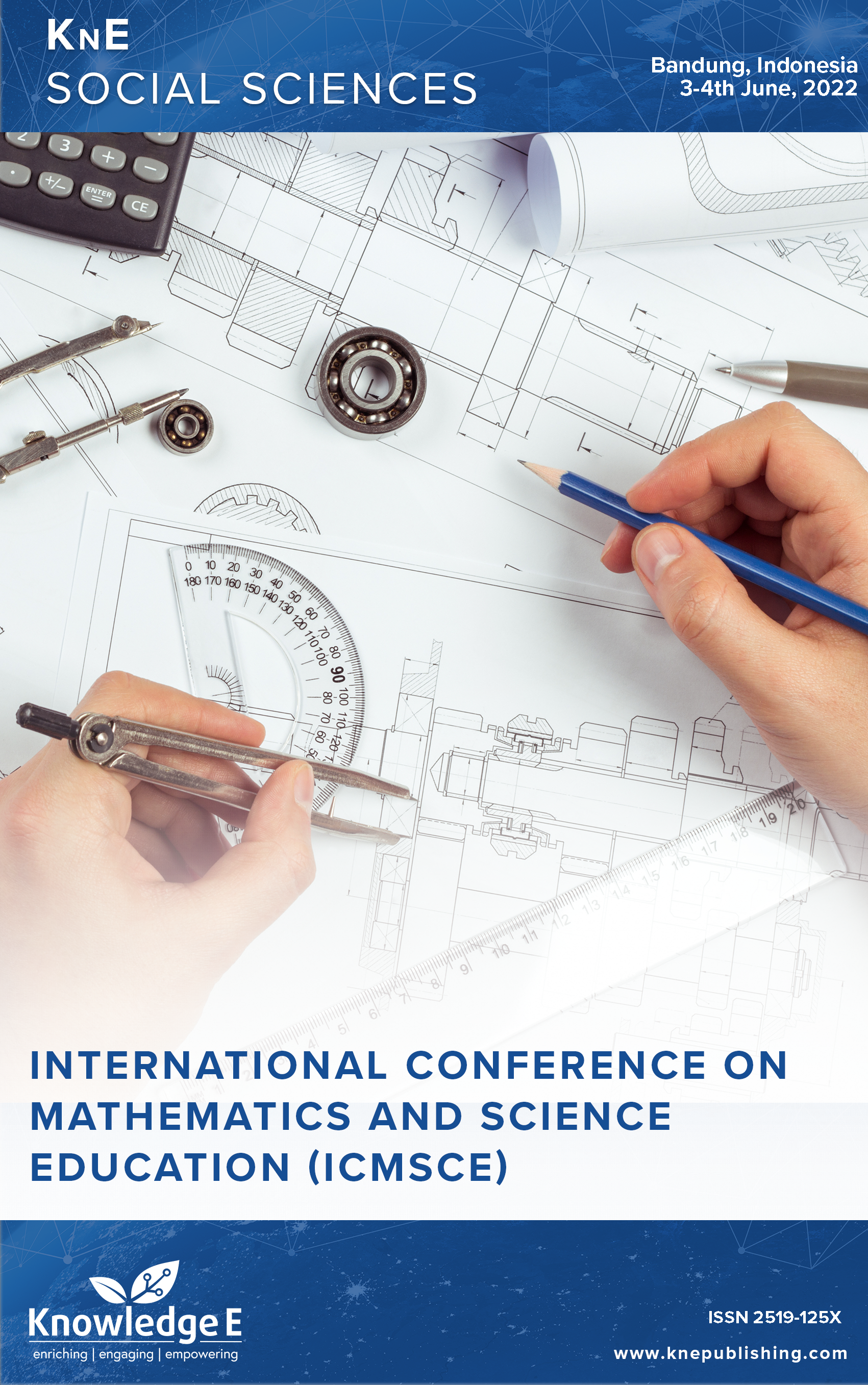The Effect of the COVID-19 Pandemic on the Attention, Attitude and Awareness Indicators of Senior High School Students When Learning Chemistry
DOI:
https://doi.org/10.18502/kss.v9i13.15916Abstract
The COVID-19 pandemic had an impact on students when learning chemistry because it affected their attention, attitude, and awareness. Therefore, this study aimed to determine students’ attention, attitude, and awareness when learning chemistry. This study used a non-experimental quantitative approach. Observation, interviews, questionnaires, and documentation were data collection techniques used in this study. A closed questionnaire was used and was compiled based on content validity and was tested for reliability. The data from the research showed that the student’s percentage for attention was 55.97%, attitude was 56.48%, and awareness was 54.85%. It was also found that factors that influenced students during the COVID-19 pandemic were level of intelligence, teacher’s creativity in teaching, and having certain methods of observation and learning have certain conditions. Good physical and health, and the teaching style of the teacher who did not provide examples of problems in solving them.
Keywords: COVID-19 pandemic, chemistry, attention, attitude, awareness
References
Singhal MK. Facilitating virtual medicinal chemistry active learning assignments using advanced zoom features during covid-19 campus closure. J Chem Educ. 2020;97(9):2711–4. DOI: https://doi.org/10.1021/acs.jchemed.0c00675
Huang J. Successes and Challenges: Online Teaching and Learning of Chemistry in Higher Education in China in the Time of COVID-19. J Chem Educ. 2020;97(9):2810– 4. DOI: https://doi.org/10.1021/acs.jchemed.0c00671
Bokosmaty R, Bridgeman A, Muir M. Using a Partially Flipped Learning Model to Teach First Year Undergraduate Chemistry. J Chem Educ. 2019;96(4):629–39. DOI: https://doi.org/10.1021/acs.jchemed.8b00414
Franco J, Provencher BA. Using a Multitouch Book to Enhance the Student Experience in Organic Chemistry. J Chem Educ. 2019;96(3):586–92. DOI: https://doi.org/10.1021/acs.jchemed.8b00703
Engel. Paper Knowledge. Toward a Media History of Documents. 2014.
Sanga Lamsari Purba L, Sormin E, Harefa N, Sumiyati S. Effectiveness of use of online games kahoot! chemical to improve student learning motivation. Jurnal Pendidikan Kimia. 2019;11(2):57–66. DOI: https://doi.org/10.24114/jpkim.v11i2.14463
Bunce DM, Flens EA, Neiles KY. How long can students pay attention in class? A study of student attention decline using clickers. J Chem Educ. 2010;87(12):1438–43. DOI: https://doi.org/10.1021/ed100409p
Chowdhury P, Rankhumise MP, Simelane-Mnisi S, Mafa-Theledi ON ON. Attitude and Performance: A Universal Co-Relation, Example from a Chemistry Classroom. Journal of Turkish Science Education. 2020;17(4):603–16. DOI: https://doi.org/10.36681/tused.2020.48
Rocabado GA, Kilpatrick NA, Mooring SR, Lewis JE. Can We Compare Attitude Scores among Diverse Populations? An Exploration of Measurement Invariance Testing to Support Valid Comparisons between Black Female Students and Their Peers in an Organic Chemistry Course. J Chem Educ. 2019;96(11):2371–82. DOI: https://doi.org/10.1021/acs.jchemed.9b00516
Penn M, Ramnarain U. South African university students’ attitudes towards chemistry learning in a virtually simulated learning environment. Chem Educ Res Pract. 2019;20(4):699–709. DOI: https://doi.org/10.1039/C9RP00014C
Nennig HT, Idárraga KL, Salzer LD, Bleske-Rechek A, Theisen RM. Comparison of student attitudes and performance in an online and a face-to-face inorganic chemistry course. Chem Educ Res Pract. 2020;21(1):168–77. DOI: https://doi.org/10.1039/C9RP00112C
Wang Y, Rocabado GA, Lewis JE, Lewis SE. Prompts to Promote Success: Evaluating Utility Value and Growth Mindset Interventions on General Chemistry Students’ Attitude and Academic Performance. J Chem Educ. 2021;98(5):1476–88. DOI: https://doi.org/10.1021/acs.jchemed.0c01497
Winkelmann K, Keeney-Kennicutt W, Fowler D, Lazo Macik M, Perez Guarda P, Joan Ahlborn C. Learning gains and attitudes of students performing chemistry experiments in an immersive virtual world. Interact Learn Environ. 2020;28(5):620– 34. DOI: https://doi.org/10.1080/10494820.2019.1696844
Woldeamanuel MM, Selassie GG. Motivation and attitude towards learning chemistry. African Journal of Chemical Education. 2019;9(2):70–88.
Fahmidani Y, Rohaeti E. Attitude toward chemistry: Student’s perception based on learning experience. Journal of Physics: Conference Series. 2020;1440(1). https://doi.org/10.1088/1742-6596/1440/1/012016. DOI: https://doi.org/10.1088/1742-6596/1440/1/012016
Kirkpatrick AJ, Cantrell MA, Smeltzer SC. Relationships among nursing student palliative care knowledge, experience, self-awareness, and performance: an endof- life simulation study. Nurse Educ Today. 2019 Feb;73:23–30. DOI: https://doi.org/10.1016/j.nedt.2018.11.003
Ho K, Svidinskiy BS, Smith SR, Lovallo CC, Clark DB. The integration of a community service learning water project in a post-secondary chemistry lab. Chem Educ Res Pract. 2021;22(3):602–15. DOI: https://doi.org/10.1039/D0RP00374C
Aliman M, Budijanto B, Sumarmi S, Astina IK. Budijanto, Sumarmi, and I.K. Astina, “Improving environmental awareness of high school students’ in Malang city through earthcomm learning in the geography class,”. Int J Instr. 2019;12(4):79–94. DOI: https://doi.org/10.29333/iji.2019.1246a
Maison M, Kurniawan DA, Anggraini L. D.A. Kurniawan*, and L. Anggraini, “Perception, Attitude, and Student Awareness in Working on Online Tasks During the Covid-19 Pandemic.,”. Jurnal Pendidikan Sains Indonesia. 2021;9(1):108–18. DOI: https://doi.org/10.24815/jpsi.v9i1.18039
Chen SY, Liu SY. Using augmented reality to experiment with elements in a chemistry course. Comput Human Behav. 2020;111(May):106418. DOI: https://doi.org/10.1016/j.chb.2020.106418
Casey JE, Pennington LK, Lopez D. Increasing hispanic students’ awareness and use of floor-robots through structured activities. Contemp Educ Technol. 2021;13(1):1–14. DOI: https://doi.org/10.30935/cedtech/8706
Spearman C. Spearman’s rank correlation coefficient. Royal geographical society. 2009.
Cain J, Black EP, Rohr J. An audience response system strategy to improve student motivation, attention, and feedback. American Journal of Pharmaceutical Education. 2009;73(2). https://doi.org/10.5688/aj730221. DOI: https://doi.org/10.1016/S0002-9459(24)00592-8
Wahyudiati D, Rohaeti E, Irwanto A, Wiyarsi A, Sumardi L. Wiyarsi, and L. Sumardi, “Attitudes toward chemistry, self-efficacy, and learning experiences of pre-servicechemistry teachers: grade level and gender differences.,”. Int J Instr. 2020;13(1):235– 54. DOI: https://doi.org/10.29333/iji.2020.13116a
Atieh EL, York DM. Through the Looking Class: When Peer Leader Learning Attitudes Are Not What They Seem. J Chem Educ. 2020 Aug;97(8):2078–90. DOI: https://doi.org/10.1021/acs.jchemed.0c00129
Karaoglan Yilmaz FG, Yilmaz R. Impact of pedagogic agent-mediated metacognitive support towards increasing task and group awareness in CSCL. Comput Educ. 2019;134( January):1–14. DOI: https://doi.org/10.1016/j.compedu.2019.02.001

